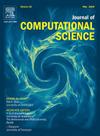Influence of the properties of the elasticity modulus in the nasopharynx on the hydrodynamic characteristics of the flow in the upper respiratory tract
IF 3.1
3区 计算机科学
Q2 COMPUTER SCIENCE, INTERDISCIPLINARY APPLICATIONS
引用次数: 0
Abstract
In this study, the influence of the elasticity modulus (5–25 kPa) and inlet boundary conditions on the distribution of velocity, pressure, shear stress and strain in the upper airways was investigated using computational fluid dynamics (CFD) and fluid-structure interaction (FSI) models. Sinusoidal velocity profiles at the entrance to the nasal sinuses with oscillation amplitudes of 1.2 m/s, 2.4 m/s, 3.6 m/s were considered. The results show that the maximum value of deformation in the nasopharyngeal region occurred at a value of Young's modulus of 5 kPa, and values from 15 to 25 kPa gave deformation values lower by more than 20 % and had insignificant differences. In addition, the CFD model showed higher pressure and shear stress values than the FSI model, and the maximum velocity of the FSI models was higher than that of the CFD model. This study provides new data on the effect of modulus and inlet boundary conditions on velocity, pressure, shear stress, and strain distributions in the upper airways.
鼻咽部弹性模量特性对上呼吸道流体动力学特性的影响
本研究采用计算流体力学(CFD)和流固耦合(FSI)模型,研究了弹性模量(5-25 kPa)和进气道边界条件对上气道速度、压力、剪切应力和应变分布的影响。考虑振荡幅值为1.2 m/s、2.4 m/s、3.6 m/s的鼻窦入口正弦速度分布。结果表明,在杨氏模量为5 kPa时,鼻咽区变形最大值出现,在15 ~ 25 kPa时,变形值降低20% %以上,且差异不显著。此外,CFD模型的压力和剪应力值高于FSI模型,FSI模型的最大速度高于CFD模型。该研究提供了模量和入口边界条件对上呼吸道速度、压力、剪应力和应变分布影响的新数据。
本文章由计算机程序翻译,如有差异,请以英文原文为准。
求助全文
约1分钟内获得全文
求助全文
来源期刊

Journal of Computational Science
COMPUTER SCIENCE, INTERDISCIPLINARY APPLICATIONS-COMPUTER SCIENCE, THEORY & METHODS
CiteScore
5.50
自引率
3.00%
发文量
227
审稿时长
41 days
期刊介绍:
Computational Science is a rapidly growing multi- and interdisciplinary field that uses advanced computing and data analysis to understand and solve complex problems. It has reached a level of predictive capability that now firmly complements the traditional pillars of experimentation and theory.
The recent advances in experimental techniques such as detectors, on-line sensor networks and high-resolution imaging techniques, have opened up new windows into physical and biological processes at many levels of detail. The resulting data explosion allows for detailed data driven modeling and simulation.
This new discipline in science combines computational thinking, modern computational methods, devices and collateral technologies to address problems far beyond the scope of traditional numerical methods.
Computational science typically unifies three distinct elements:
• Modeling, Algorithms and Simulations (e.g. numerical and non-numerical, discrete and continuous);
• Software developed to solve science (e.g., biological, physical, and social), engineering, medicine, and humanities problems;
• Computer and information science that develops and optimizes the advanced system hardware, software, networking, and data management components (e.g. problem solving environments).
 求助内容:
求助内容: 应助结果提醒方式:
应助结果提醒方式:


